VOLVO XC90 TWIN ENGINE 2019 Owners Manual
Manufacturer: VOLVO, Model Year: 2019, Model line: XC90 TWIN ENGINE, Model: VOLVO XC90 TWIN ENGINE 2019Pages: 697, PDF Size: 10.33 MB
Page 321 of 697
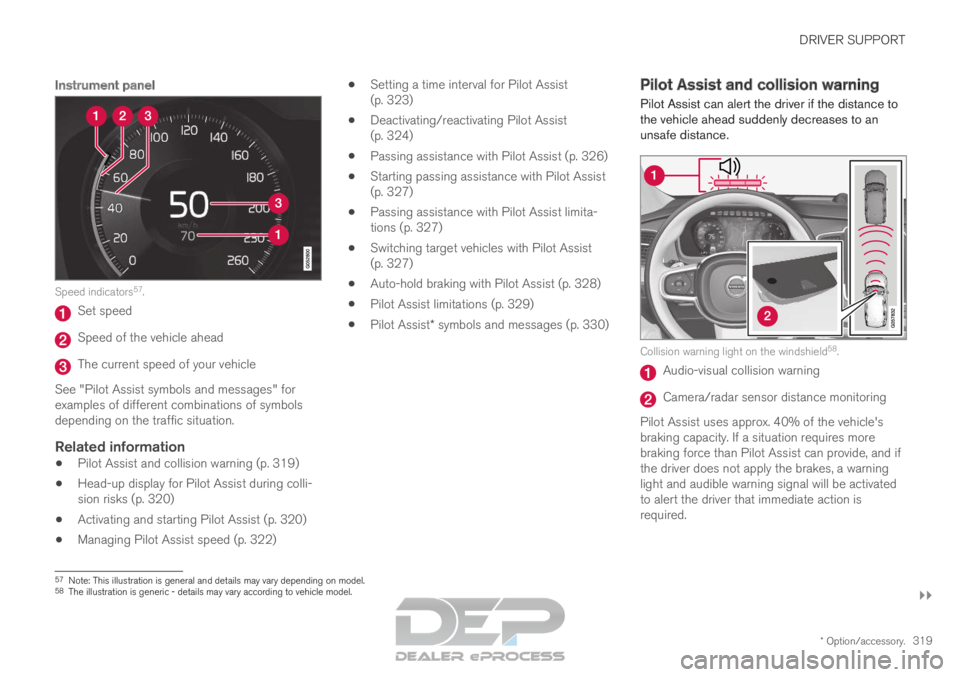
DRIVER SUPPORT
}}
* Option/accessory. 319
Instrument panelSpeed indicators
57
. Set speed
Speed of the vehicle ahead
The current speed of your vehicle
See "Pilot Assist symbols and messages" for
examples of different combinations of symbols
depending on the traffic situation.
Related information
Pilot Assist and collision warning (p. 319)
Head-up display for Pilot Assist during colli-
sion risks (p. 320)
Activating and starting Pilot Assist (p. 320)
Managing Pilot Assist speed (p. 322)
Setting a time interval for Pilot Assist
(p. 323)
Deactivating/reactivating Pilot Assist
(p. 324)
Passing assistance with Pilot Assist (p. 326)
Starting passing assistance with Pilot Assist
(p. 327)
Passing assistance with Pilot Assist limita-
tions (p. 327)
Switching target vehicles with Pilot Assist
(p. 327)
Auto-hold braking with Pilot Assist (p. 328)
Pilot Assist limitations (p. 329)
Pilot Assist* symbols and messages (p. 330) Pilot Assist and collision warning
Pilot Assist can alert the driver if the distance to
the vehicle ahead suddenly decreases to an
unsafe distance. Collision warning light on the windshield
58
. Audio-visual collision warning
Camera/radar sensor distance monitoring
Pilot Assist uses approx. 40% of the vehicle's
braking capacity. If a situation requires more
braking force than Pilot Assist can provide, and if
the driver does not apply the brakes, a warning
light and audible warning signal will be activated
to alert the driver that immediate action is
required. 57
Note: This illustration is general and details may vary depending on mod\
el.
58 The illustration is generic - details may vary according to vehicle mode\
l.
Page 322 of 697
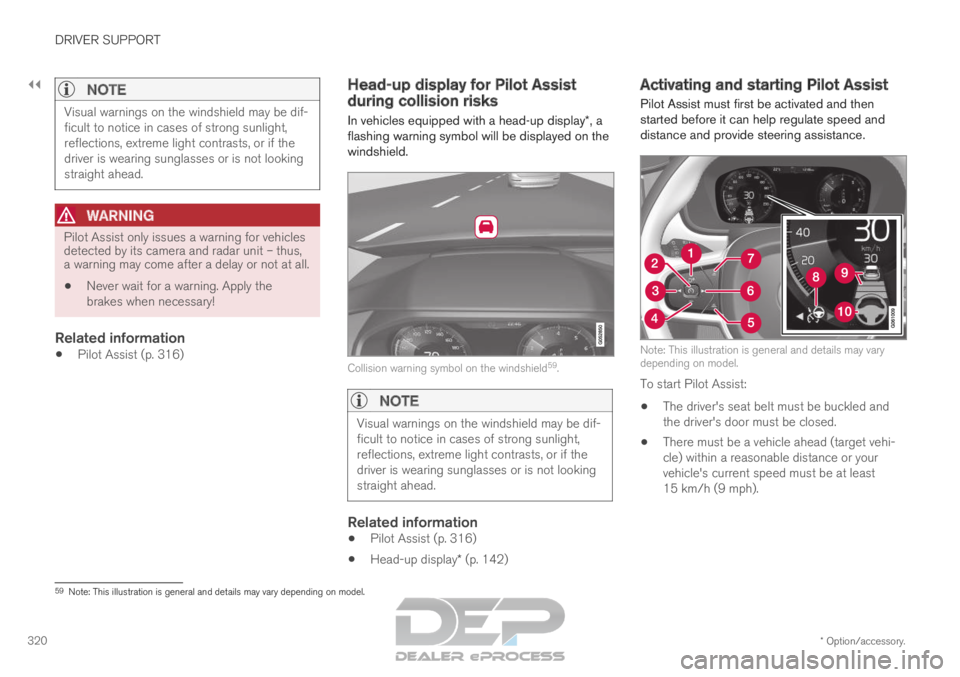
||DRIVER SUPPORT
* Option/accessory.
320
NOTE Visual warnings on the windshield may be dif-
ficult to notice in cases of strong sunlight,
reflections, extreme light contrasts, or if the
driver is wearing sunglasses or is not looking
straight ahead.
WARNING
Pilot Assist only issues a warning for vehicles
detected by its camera and radar unit – thus,
a warning may come after a delay or not at all.
Never wait for a warning. Apply the
brakes when necessary!
Related information
Pilot Assist (p. 316) Head-up display for Pilot Assist
during collision risks
In vehicles equipped with a head-up display*, a
flashing warning symbol will be displayed on the
windshield. Collision warning symbol on the windshield
59
.
NOTE Visual warnings on the windshield may be dif-
ficult to notice in cases of strong sunlight,
reflections, extreme light contrasts, or if the
driver is wearing sunglasses or is not looking
straight ahead.
Related information
Pilot Assist (p. 316)
Head-up display* (p. 142) Activating and starting Pilot Assist
Pilot Assist must first be activated and then
started before it can help regulate speed and
distance and provide steering assistance.
Note: This illustration is general and details may vary
depending on model.
To start Pilot Assist:
The driver's seat belt must be buckled and
the driver's door must be closed.
There must be a vehicle ahead (target vehi-
cle) within a reasonable distance or your
vehicle's current speed must be at least
15 km/h (9 mph). 59
Note: This illustration is general and details may vary depending on mod\
el.
Page 323 of 697

DRIVER SUPPORT
321
With Adaptive Cruise Control in standby mode:
1. Press the ▶ button on the steering wheel (6).
>
The symbol will change to Pilot
Assist in standby mode (8).
2. Press the button on the steering wheel
(2).
>
Pilot Assist will start and the current
speed will be stored, which will be shown
by numbers in the center of the speedom-
eter.
...or...
With Adaptive Cruise Control started:
– Press the ▶ button on the steering wheel (6).
>
Pilot Assist will start.
Pilot Assist's steering assis-
tance is only active when the
steering wheel symbol (2)
changes from GRAY to
GREEN.
Pilot Assist will only regulate
the time interval to the vehicle ahead when the
distance symbol shows a vehicle (1) over the
steering wheel symbol. A speed interval will be marked
at the same time.
The higher speed is the set
speed for your vehicle and the
lower speed is the speed of the
vehicle ahead (target vehicle).
Hands on the steering wheelPilot Assist only functions if the driver's hands
are on the steering wheel.
If Pilot Assist detects that the
driver's hands are not on the
steering wheel, a symbol and
text message will appear to
instruct the driver to actively
steer the vehicle. If the driver's hands are still detected on the
steering wheel after a few seconds have passed,
the instructions to actively steer the vehicle will
be repeated, accompanied by an audible signal.
If Pilot Assist still does not detect the driver's
hands on the steering wheel after a few more
seconds have passed, the audible signal will
become intense and the steering function will
switch off. Pilot Assist must then be reactivated
by pressing the
button on the steering
wheel.
NOTE Note that the Pilot Assist function only works
when the driver's hands are on the steering
wheel.
Related information
Pilot Assist (p. 316)
Page 324 of 697
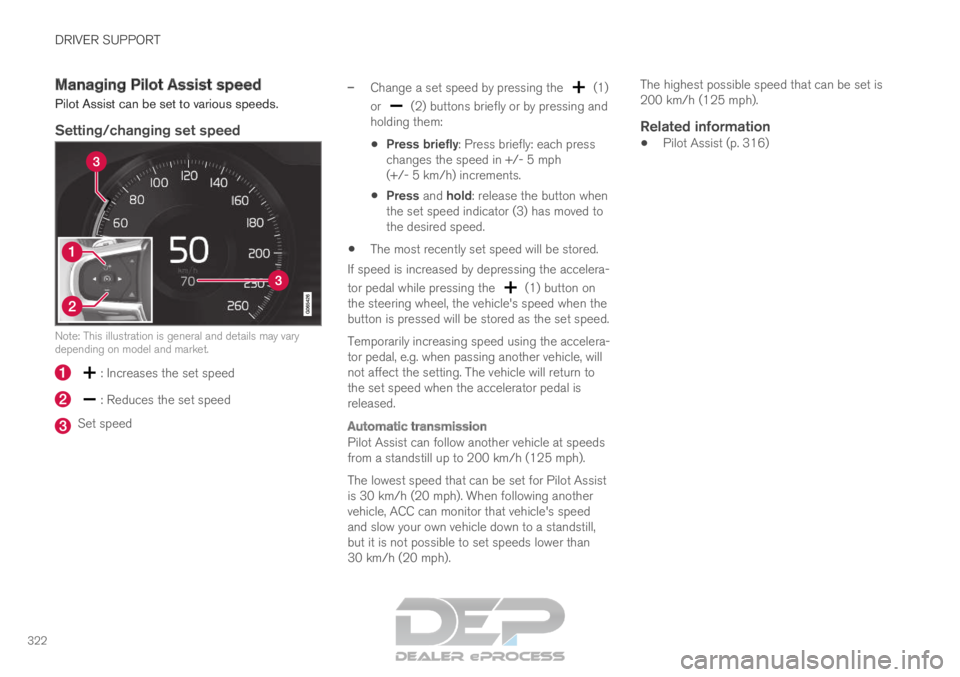
DRIVER SUPPORT
322Managing Pilot Assist speed
Pilot Assist can be set to various speeds.
Setting/changing set speed
Note: This illustration is general and details may vary
depending on model and market.
: Increases the set speed
: Reduces the set speed
Set speed –
Change a set speed by pressing the (1)
or (2) buttons briefly or by pressing and
holding them:
Press briefly: Press briefly: each press
changes the speed in +/- 5 mph
(+/- 5 km/h) increments.
Press and hold: release the button when
the set speed indicator (3) has moved to
the desired speed.
The most recently set speed will be stored.
If speed is increased by depressing the accelera-
tor pedal while pressing the (1) button on
the steering wheel, the vehicle's speed when the
button is pressed will be stored as the set speed.
Temporarily increasing speed using the accelera-
tor pedal, e.g. when passing another vehicle, will
not affect the setting. The vehicle will return to
the set speed when the accelerator pedal is
released.
Automatic transmission
Pilot Assist can follow another vehicle at speeds
from a standstill up to 200 km/h (125 mph).
The lowest speed that can be set for Pilot Assist
is 30 km/h (20 mph). When following another
vehicle, ACC can monitor that vehicle's speed
and slow your own vehicle down to a standstill,
but it is not possible to set speeds lower than
30 km/h (20 mph). The highest possible speed that can be set is
200 km/h (125 mph).
Related information
Pilot Assist (p. 316)
Page 325 of 697

DRIVER SUPPORT
}}
* Option/accessory. 323
Setting a time interval for Pilot
Assist
Pilot Assist
can be set to different time intervals.
Different time intervals to the
vehicle ahead can be selected
and are shown in the instru-
ment panel as 1–5 horizontal
bars. The more bars, the longer
the time interval. One bar rep-
resents an interval of
approx. 1 second to the vehicle ahead. 5 bars
represents approx. 3 seconds.
NOTE When the symbol in the instrument panel
shows a vehicle and a steering wheel, Pilot
Assist follows a vehicle ahead at a preset
time interval.
When only a steering wheel is shown, there is
no vehicle ahead within a reasonable dis-
tance. Controls for setting a time interval
60
. Reduce the time interval
Increase the time interval
Distance indicator
– Press the (1) or (2) button to decrease or
increase the time interval.
>
The distance indicator (3) shows the cur-
rent time interval.
In order to follow the vehicle ahead as smoothly
as possible, Pilot Assist allows the time interval to
vary considerably in certain situations. For exam-
ple, at low speeds and short distances to the
vehicle ahead, Pilot Assist increases the time
interval slightly.
NOTE
The greater the vehicles' speed, the
greater the distance between them for a
set time interval.
Only use the time intervals permitted by
local traffic regulations.
If Pilot Assist does not seem to respond
with a speed increase when activated, it
may be because the time interval to the
vehicle ahead is shorter than the set time
interval.
WARNING
Only use a time interval suitable for the
current traffic conditions.
The driver should be aware that short
time intervals give them limited time to
react and act to any unforeseen traffic
situation.
Setting how Pilot Assist should
maintain distance* to the vehicle ahead
The driver can choose different drive modes to
determine how Pilot Assist should maintain a
time interval to the vehicle ahead. Settings are
made using the DRIVE MODE controls. 60
Note: This illustration is general and details may vary depending on mod\
el.
Page 326 of 697

||DRIVER SUPPORT
324
Select one of the following:
Eco - Pilot Assist will focus on providing
optimal fuel economy, which will increase the
time interval to the vehicle ahead.
Comfort - Pilot Assist will focus on following
the set time interval to the vehicle ahead as
smoothly as possible.
Dynamic - Pilot Assist will focus on follow-
ing the set time interval to the vehicle ahead
more exactly, which could mean faster accel-
eration and heavier braking.
For more information, see "Drive modes".
Related information
Pilot Assist (p. 316)
Drive modes (p. 454)
Managing Cruise Control speed (p. 293) Deactivating/reactivating Pilot
Assist
Pilot Assist
can be temporarily put into standby
mode and then reactivated.
Deactivating and putting Pilot Assist in
standby mode Note: This illustration is general and details may vary
depending on model.
To temporarily deactivate Pilot Assist and put it in
standby mode:
–
Press the button on the steering wheel
(2).
>
Pilot Assist goes into standby mode - the
symbol (8) in the instrument panel
changes color from WHITE to GRAY and
the set speed in the center of the speed-
ometer will change from BEIGE to GRAY.
...or... –
Press the ◀ button on the steering wheel (3).
>
Pilot Assist is turned off and Adaptive
Cruise Control will go into active mode.
WARNING
With Pilot Assist in standby mode, the
driver must intervene and steer and regu-
late both speed and distance to the vehi-
cle ahead.
If the vehicle comes too close to a vehicle
ahead when Pilot Assist is in standby
mode, the driver is instead warned of the
short distance by the Distance Alert func-
tion.
Page 327 of 697
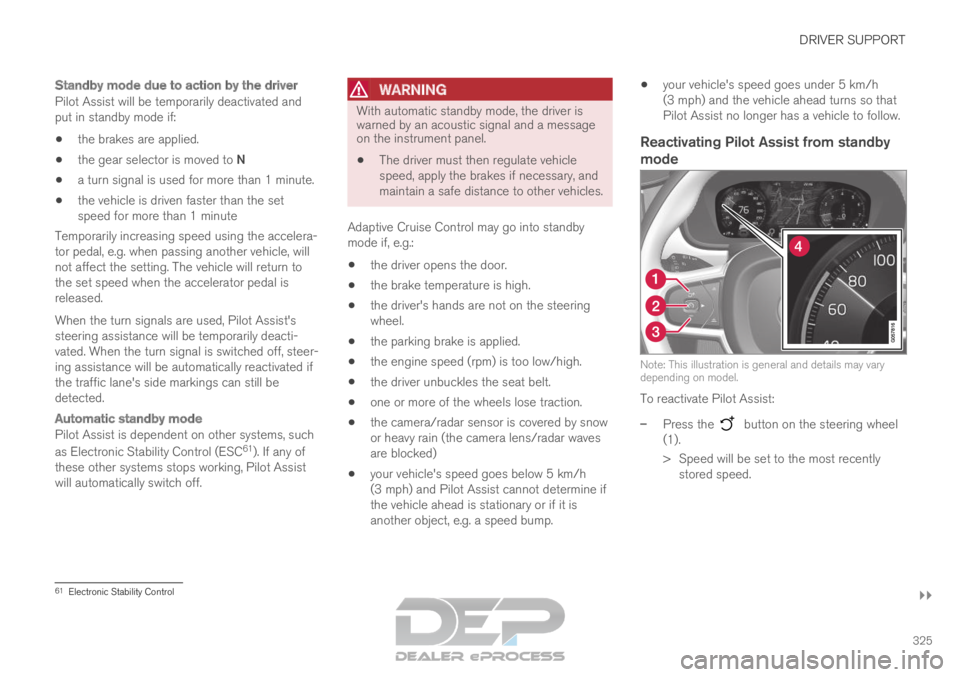
DRIVER SUPPORT
}}
325
Standby mode due to action by the driver
Pilot Assist will be temporarily deactivated and
put in standby mode if: the brakes are applied.
the gear selector is moved to N
a turn signal is used for more than 1 minute.
the vehicle is driven faster than the set
speed for more than 1 minute
Temporarily increasing speed using the accelera-
tor pedal, e.g. when passing another vehicle, will
not affect the setting. The vehicle will return to
the set speed when the accelerator pedal is
released.
When the turn signals are used, Pilot Assist's
steering assistance will be temporarily deacti-
vated. When the turn signal is switched off, steer-
ing assistance will be automatically reactivated if
the traffic lane's side markings can still be
detected.
Automatic standby mode
Pilot Assist is dependent on other systems, such
as Electronic Stability Control (ESC 61
). If any of
these other systems stops working, Pilot Assist
will automatically switch off.
WARNING With automatic standby mode, the driver is
warned by an acoustic signal and a message
on the instrument panel.
The driver must then regulate vehicle
speed, apply the brakes if necessary, and
maintain a safe distance to other vehicles.
Adaptive Cruise Control may go into standby
mode if, e.g.:
the driver opens the door.
the brake temperature is high.
the driver's hands are not on the steering
wheel.
the parking brake is applied.
the engine speed (rpm) is too low/high.
the driver unbuckles the seat belt.
one or more of the wheels lose traction.
the camera/radar sensor is covered by snow
or heavy rain (the camera lens/radar waves
are blocked)
your vehicle's speed goes below 5 km/h
(3 mph) and Pilot Assist cannot determine if
the vehicle ahead is stationary or if it is
another object, e.g. a speed bump.
your vehicle's speed goes under 5 km/h
(3 mph) and the vehicle ahead turns so that
Pilot Assist no longer has a vehicle to follow.
Reactivating Pilot Assist from standby
mode Note: This illustration is general and details may vary
depending on model.
To reactivate Pilot Assist:
–
Press the button on the steering wheel
(1).
>
Speed will be set to the most recently
stored speed. 61
Electronic Stability Control
Page 328 of 697

||DRIVER SUPPORT
326
WARNING
A noticeable increase in speed may follow
when the speed is resumed with the
steering wheel button.
Related information
Pilot Assist (p. 316) Passing assistance with Pilot Assist
Pilot Assist can assist the driver when passing
other vehicles.
How passing assistance worksWhen Pilot Assist is following another vehicle
and you indicate that you intend to pass that
vehicle by using the turn signal 62
, Pilot Assist will
begin accelerating toward the vehicle ahead
before your vehicle has moved into the passing
lane.
The function will then delay a speed reduction to
avoid early braking as your vehicle approaches a
slower-moving vehicle.
The function remains active until your vehicle has
passed the other vehicle.
WARNING Please note that this function can be acti-
vated in more situations than just passing
another vehicle, such as when a direction indi-
cator is used to indicate a lane change or
before exiting to another road – the vehicle
will then briefly accelerate.
Related information
Pilot Assist (p. 316)
Starting passing assistance with Pilot Assist
(p. 327)
Passing assistance with Pilot Assist limita-
tions (p. 327) 62
Only the left-hand turn signal for left-hand drive vehicles, or right-ha\
nd turn signal for right-hand drive vehicles.
Page 329 of 697
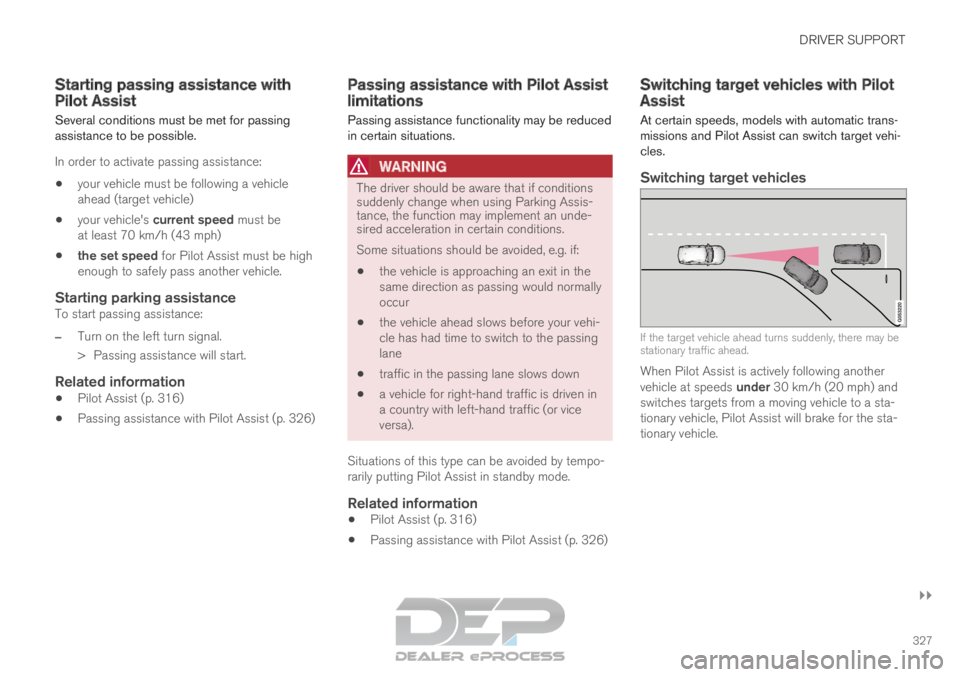
DRIVER SUPPORT
}}
327
Starting passing assistance with
Pilot Assist
Several conditions must be met for passing
assistance to be possible.
In order to activate passing assistance:
your vehicle must be following a vehicle
ahead (target vehicle)
your vehicle's current speed must be
at least 70 km/h (43 mph)
the set speed for Pilot Assist must be high
enough to safely pass another vehicle.
Starting parking assistanceTo start passing assistance:
–
Turn on the left turn signal.
>
Passing assistance will start.
Related information
Pilot Assist (p. 316)
Passing assistance with Pilot Assist (p. 326) Passing assistance with Pilot Assist
limitations
Passing assistance functionality may be reduced
in certain situations.
WARNING The driver should be aware that if conditions
suddenly change when using Parking Assis-
tance, the function may implement an unde-
sired acceleration in certain conditions.
Some situations should be avoided, e.g. if:
the vehicle is approaching an exit in the
same direction as passing would normally
occur
the vehicle ahead slows before your vehi-
cle has had time to switch to the passing
lane
traffic in the passing lane slows down
a vehicle for right-hand traffic is driven in
a country with left-hand traffic (or vice
versa).
Situations of this type can be avoided by tempo-
rarily putting Pilot Assist in standby mode.
Related information
Pilot Assist (p. 316)
Passing assistance with Pilot Assist (p. 326) Switching target vehicles with Pilot
Assist
At certain speeds, models with automatic trans-
missions and
Pilot Assist can switch target vehi-
cles.
Switching target vehicles If the target vehicle ahead turns suddenly, there may be
stationary traffic ahead.
When Pilot Assist is actively following another
vehicle at speeds under 30 km/h (20 mph) and
switches targets from a moving vehicle to a sta-
tionary vehicle,
Pilot Assist will brake for the sta-
tionary vehicle.
Page 330 of 697
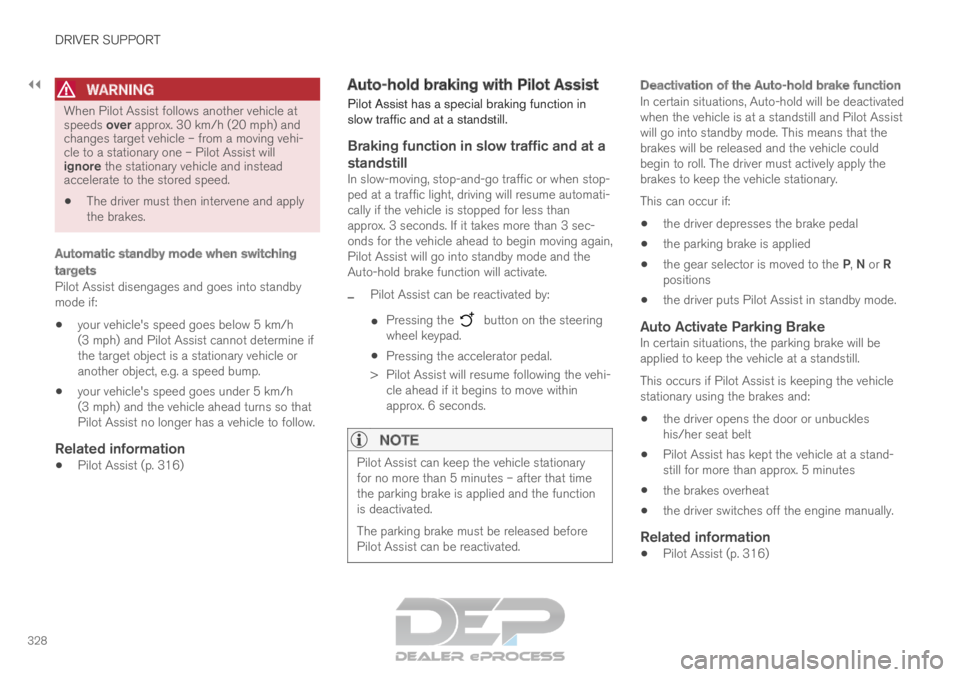
||DRIVER SUPPORT
328
WARNING
When Pilot Assist follows another vehicle at
speeds over approx. 30 km/h (20 mph) and
changes target vehicle – from a moving vehi-
cle to a stationary one – Pilot Assist will
ignore the stationary vehicle and instead
accelerate to the stored speed.
The driver must then intervene and apply
the brakes.
Automatic standby mode when switching
targets
Pilot Assist disengages and goes into standby
mode if:
your vehicle's speed goes below 5 km/h
(3 mph) and Pilot Assist cannot determine if
the target object is a stationary vehicle or
another object, e.g. a speed bump.
your vehicle's speed goes under 5 km/h
(3 mph) and the vehicle ahead turns so that
Pilot Assist no longer has a vehicle to follow.
Related information
Pilot Assist (p. 316) Auto-hold braking with Pilot Assist
Pilot Assist has a special braking function in
slow traffic and at a standstill.
Braking function in slow traffic and at a
standstill
In slow-moving, stop-and-go traffic or when stop-
ped at a traffic light, driving will resume automati-
cally if the vehicle is stopped for less than
approx. 3 seconds. If it takes more than 3 sec-
onds for the vehicle ahead to begin moving again,
Pilot Assist will go into standby mode and the
Auto-hold brake function will activate.
– Pilot Assist can be reactivated by:
Pressing the button on the steering
wheel keypad.
Pressing the accelerator pedal.
>
Pilot Assist will resume following the vehi-
cle ahead if it begins to move within
approx. 6 seconds.
NOTE Pilot Assist can keep the vehicle stationary
for no more than 5 minutes – after that time
the parking brake is applied and the function
is deactivated.
The parking brake must be released before
Pilot Assist can be reactivated.
Deactivation of the Auto-hold brake function
In certain situations, Auto-hold will be deactivated
when the vehicle is at a standstill and Pilot Assist
will go into standby mode. This means that the
brakes will be released and the vehicle could
begin to roll. The driver must actively apply the
brakes to keep the vehicle stationary.
This can occur if:
the driver depresses the brake pedal
the parking brake is applied
the gear selector is moved to the P, N or R
positions
the driver puts Pilot Assist in standby mode.
Auto Activate Parking BrakeIn certain situations, the parking brake will be
applied to keep the vehicle at a standstill.
This occurs if Pilot Assist is keeping the vehicle
stationary using the brakes and:
the driver opens the door or unbuckles
his/her seat belt
Pilot Assist has kept the vehicle at a stand-
still for more than approx. 5 minutes
the brakes overheat
the driver switches off the engine manually.
Related information
Pilot Assist (p. 316)